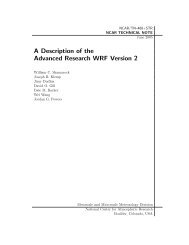extended abstract P26 - MMM
extended abstract P26 - MMM
extended abstract P26 - MMM
You also want an ePaper? Increase the reach of your titles
YUMPU automatically turns print PDFs into web optimized ePapers that Google loves.
smaller scales than solved by the model, like<br />
mesovortices, could lead to additional local<br />
intensifications of the wind speed [Hamid,<br />
2010]. That the maximum wind speed is found<br />
in the 1 km model run is probably related to<br />
different initial conditions and a different<br />
development of precipitating systems in the 1<br />
km and 500 m runs. Similar wind speed<br />
maxima could however occur in the 500 m run.<br />
The present study does not indicate whether<br />
the results of the 500 m run are more realistic<br />
than those of the 1 km run.<br />
During the passage of the highest wind speeds<br />
near Vethuizen, the wind direction varied from<br />
southwesterly in the east of the precipitation<br />
system to more south-southeasterly in the west<br />
of the system (Figure 4). This is typical for a<br />
downburst connected to a squall line. The<br />
southwesterly flow is perpendicular to the<br />
orientation of the high voltage line Doetinchem-<br />
Ulft (the pylons that were blown down<br />
belonged to this line).<br />
The wind patterns that are found at 35 and 70<br />
meter height are similar in structure to the<br />
pattern at 10 meter, but with higher wind<br />
speeds (maxima of 160 km/h at 35 m and 171<br />
km/h at 70 m).<br />
5. Summary and conclusion<br />
WRF seems capable of simulating the complex<br />
weather of 14 July 2010. The shape (e.g. the<br />
bow echo structure), intensity and timing of the<br />
precipitation system were resolved quite well<br />
by WRF. Compared with the observed radar,<br />
the location of the extreme weather system<br />
was simulated a little more to the east. The<br />
simulation results showed a large area,<br />
spreading from west to east, with high wind<br />
speeds that moved rapidly towards the north<br />
east. The high resolution runs (500 m and 1<br />
km) revealed micro-burst structures in<br />
combination with streaks of high wind speed.<br />
The maximum simulated wind speed at 10<br />
meter height is about 134 km/h. The wind<br />
patterns at 35 and 70 meter are similar in<br />
shape, only the wind speed increases with<br />
height. During the passage of the bow echo<br />
near Vethuizen, the simulated wind direction<br />
was south-southwest, and this is in agreement<br />
with the observed damage.<br />
To conclude, WRF has proven its potential in<br />
resolving the complex weather system down to<br />
the scale of micro bursts. The maximum wind<br />
speed in the model exceeded 130 km/h at 10<br />
meter height and 170 km/h at 70 meter height.<br />
It can thus be concluded that it is<br />
meteorologically possible that wind speeds of<br />
this order of magnitude occurred in the<br />
surroundings of Vethuizen on 14 July 2010.<br />
References<br />
Chen, F., Dudhia, J., 2001. Coupling an advanced<br />
land-surface/ hydrology model with the Penn<br />
State/ NCAR MM5 modeling system. Part I:<br />
Model description and implementation,<br />
Monthly Weather Review, 129, 569–585.<br />
Chou, M.D., Suarez, M.J., Liang, X.Z., Yan, M.,<br />
1994. An Efficient Thermal Infrared Radiation<br />
Parameterization for Use in General<br />
Circulation Models, Technical Report Series on<br />
Global Modeling and Data Assimilation, NASA<br />
Technical Memorandum 104606, 3.<br />
Hamid, K., 2010. Klimatologie en morfologie van<br />
MCSs in Belgie, Meteorologica, 19 (3) (in<br />
Dutch).<br />
Holleman, I., 2007. Bias adjustment and long-term<br />
verification of radar-based precipitation<br />
estimates, Meteorological Applications, 14,<br />
195-203.<br />
Hong, S.Y., Dudhia, J., Chen, S.H., 2004. A<br />
Revised Approach to Ice Microphysical<br />
Processes for the Bulk Parameterization of<br />
Clouds and Precipitation, Monthly Weather<br />
Review, 132, 103-120.<br />
Hong, S.Y., Juang, H.M.H., Zhao, Q., 1998.<br />
Implementation of prognostic cloud scheme for<br />
a regional spectral model, Monthly Weather<br />
Review, 126, 2621-2639.<br />
Lankamp, B., Voerman, S., Nienhuis, H., 2010.<br />
Onweersoverzicht 14 juli: Derecho,<br />
omgeblazen hoogspanningsmasten, doden en<br />
zeer plaatselijk flinke schade, Weerspiegel, 37<br />
(9), 15-17 (in Dutch).<br />
Mlawer, E.J., Taubman, S.J., Brown, P.D., Iacono,<br />
M.J., Clough, S.A., 1997. Radiative transfer for<br />
inhomogeneous atmosphere. RRTM, a<br />
validated correlated-k model for the longwave,<br />
Journal of Geophysical Research -<br />
Atmospheres, 102, 16663–16682.<br />
Monin, A.S., Obukhov, A.M., 1954. Osnovnye<br />
zakonomernosti turbulentnogo<br />
peremeshivaniia v prizemnom sloe atmosfery,<br />
Akademii´a nauk SSSR, Geofizicheskii<br />
institute, USSR, Translated version by; Miller,<br />
J., 1959. Basic laws of turbulent mixing in the<br />
ground layer of the atmosphere, American<br />
meteorological Society, Cambridge, Boston,<br />
42pp, USA.<br />
Skamarock, W.C., Klemp, J.B., Dudhia, J., Gill,<br />
D.O., Barker, D.M., Wang, W., Powers, J.G.,<br />
2005. A Description of the Advanced Research<br />
WRF Version 2, NCAR Technical Note, June<br />
2005.
















